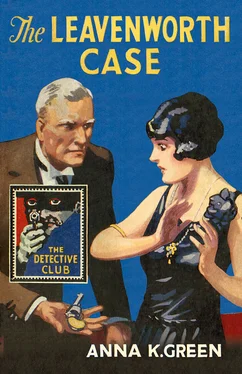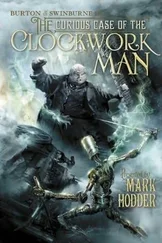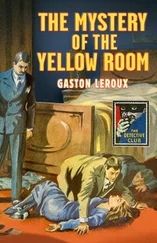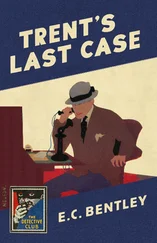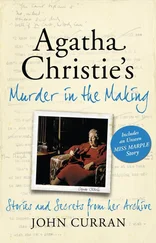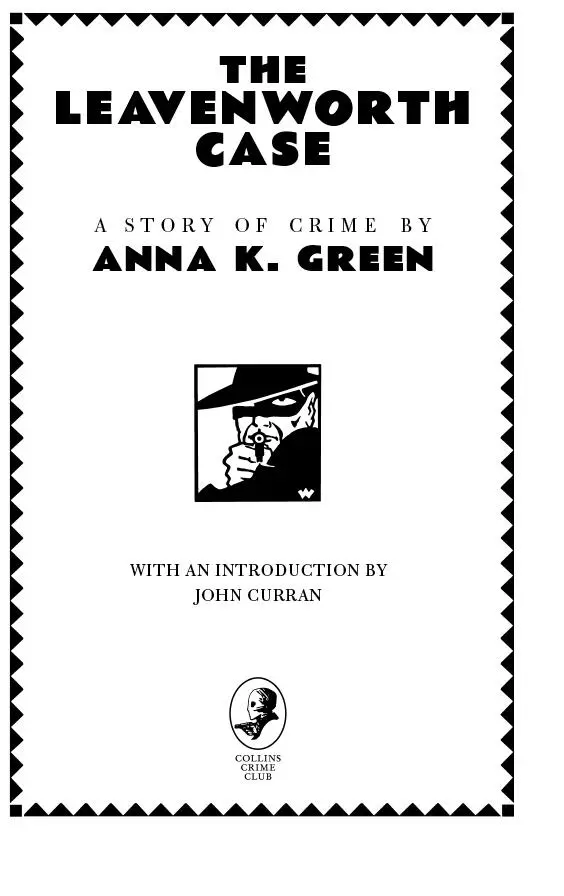
Published by COLLINS CRIME CLUB
An imprint of HarperCollins Publishers Ltd
1 London Bridge Street
London SE1 9GF
www.harpercollins.co.uk
First published by G.P. Putnam’s Sons 1878
Published by The Detective Story Club for Wm Collins Sons & Co. Ltd 1929
Introduction © John Curran 2016
Cover design © HarperCollins Publishers Ltd 1929, 2016
A catalogue copy of this book is available from the British Library.
This novel is entirely a work of fiction. The names, characters and incidents portrayed in it are the work of the author’s imagination. Any resemblance to actual persons, living or dead, events or localities is entirely coincidental.
All rights reserved under International and Pan-American Copyright Conventions. By payment of the required fees, you have been granted the non-exclusive, non-transferable right to access and read the text of this e-book on screen. No part of this text may be reproduced, transmitted, down-loaded, decompiled, reverse engineered, or stored in or introduced into any information storage and retrieval system, in any form or by any means, whether electronic or mechanical, now known or hereinafter invented, without the express written permission of HarperCollins.
Source ISBN: 9780008137595
Ebook Edition © August 2016 ISBN: 9780008137601
Version: 2016-06-22
Table of Contents
Cover
Title Page
Copyright
Introduction
Book One: The Problem
Chapter I: ‘a Great Case’
Chapter II: The Coroner’s Inquest
Chapter III: Facts and Deductions
Chapter IV: A Clue
Chapter V: Expert Testimony
Chapter VI: Side-Lights
Chapter VII: Mary Leavenworth
Chapter VIII: Circumstantial Evidence
Chapter IX: A Discovery
Chapter X: Mr Gryce Receives New Impetus
Chapter XI: The Summons
Chapter XII: Eleanore
Chapter XIII: The Problem
Book Two: Henry Clavering
Chapter XIV: Mr Gryce at Home
Chapter XV: Ways Opening
Chapter XVI: The Will of a Millionaire
Chapter XVII: The Beginning of Great Surprises
Chapter XVIII: On the Stairs
Chapter XIX: In My Office
Chapter XX: ‘Trueman! Trueman! Trueman!’
Chapter XXI: A Prejudice
Chapter XXII: Patch-Work
Chapter XXIII: The Story of a Charming Woman
Chapter XXIV: A Report Followed by Smoke
Chapter XXV: Timothy Cook
Chapter XXVI: Mr Gryce Explains Himself
Book Three: Hannah
Chapter XXVII: Amy Belden
Chapter XXVIII: A Weird Experience
Chapter XXIX: The Missing Witness
Chapter XXX: Burned Paper
Chapter XXXI: Q
Chapter XXXII: Mrs Belden’s Narrative
Chapter XXXIII: Unexpected Testimony
Book Four: The Problem Solved
Chapter XXXIV: Mr Gryce Resumes Control
Chapter XXXV: Fine Work
Chapter XXXVI: Gathered Threads
Chapter XXXVII: Culmination
Chapter XXXVIII: A Full Confession
Chapter XXXIX: The Outcome of a Great Crime
Footnotes
The Detective Story Club
About the Publisher
NOT ONLY was Anna Katharine Green (1846–1935) the first woman to write a detective novel—thereby earning the soubriquet ‘The Mother of Detective Fiction’—but she also included in it many themes and ideas that later became commonplace in the genre. fn1 And as further proof of her importance in the development of detective fiction she also introduced, later in her career, two distinct ‘types’ of detective, each very different, each contributing to an emerging form; and each much copied in the years that followed.
Born into a well-to-do family in New York’s Brooklyn Heights, Anna Catherine fn2 Green was raised, on the death of her mother, by a stepmother who encouraged Anna’s interest in writing. After graduating with a B.A. from Ripley College in Vermont in 1866—an impressive achievement for a woman at that time—she submitted some poems to the eminent American poet Ralph Waldo Emerson. He encouraged her to continue writing, but advised her to abandon poetry. Green, fearing that her lawyer father would not approve of novel-writing, began, in secret, to write a detective novel. When, on its completion, she did show it to him, he was sufficiently impressed—possibly because of the novel’s significant legal content—to arrange for a well-known critic to bring it to the attention of publisher George Putnam. The Leavenworth Case: A Lawyer’s Story was published in the US in 1878 and in the UK the following year. It was an immediate success and marked the beginning of a prolific writing career.
Appearing almost half a century before the heyday of the Golden Age, The Leavenworth Case embodies many of that era’s distinctive features. Ebenezer Gryce, described by himself as ‘a professional detective’, and one who would feature in a dozen novels over the following thirty years, investigates the murder, in his New York home, of wealthy Horatio Leavenworth. The reader is presented with the body in the locked library, a victim on the point of changing his will, a floor-plan of the murder scene, a coroner’s inquest with medical and ballistic evidence, and a second death. We encounter a lawyer-narrator, Everett Raymond, with a romantic interest in the outcome of the case, a butler, a secret marriage, an initialled handkerchief, a second floor-plan, and that device beloved of many later Golden Age writers: a numbered listing of significant points. All of these are instantly recognisable from hundreds of detective novels over the following century.
Ebenezer Gryce is described as ‘a portly, comfortable personage with an eye that never pounced’. Unlike the gimlet eye of many detectives, his rarely rested on the person he addressed but ‘was always on some insignificant object in [the] vicinity’, variously described as being ‘on intimate terms with the door-knob’ or as ‘fixing his eyes upon the poker though not with any hostile intention’. Distinct from many investigators, Gryce does not dominate or draw attention to himself and this unpretentiousness makes him a character with which readers can identify. He is self-made, self-effacing, unencumbered by family and uncomfortable in the presence of members of the upper-class; and he is a rheumatism sufferer. All of which goes some way to explain why he is rarely listed among the Great Detectives.
Viewed from today’s perspective the novel can be considered somewhat over-written and, in certain passages, sentimental. The narrator rhapsodises a shade too much over the beauty of the two main suspects; said suspects are given to fainting conveniently, and vital evidence is delayed in the interests of gallantry. But none of this should deter the reader who relishes a well-constructed plot with an unequivocal emphasis on ‘Whodunit’. And throughout the novel facts are fairly offered to the reader—the Book I inquest is a model of legal and forensic presentation—with inferences drawn from these facts. Particularly impressive also are the discussions of, and deductions drawn from, letters in Books II and IV.
The significance of Green and The Leavenworth Case can be judged by the interest shown by two eminent contemporary practitioners of the form: Arthur Conan Doyle, with whom Green had corresponded, made a point of meeting her when he visited America in 1894; and writing in The Critic on 28 January 1893, Wilkie Collins, author of the ground-breaking The Moonstone (1868), admired both the plot and the manner of its telling:
Читать дальше
